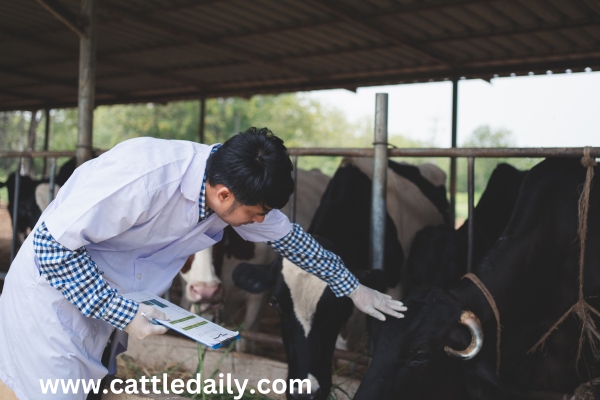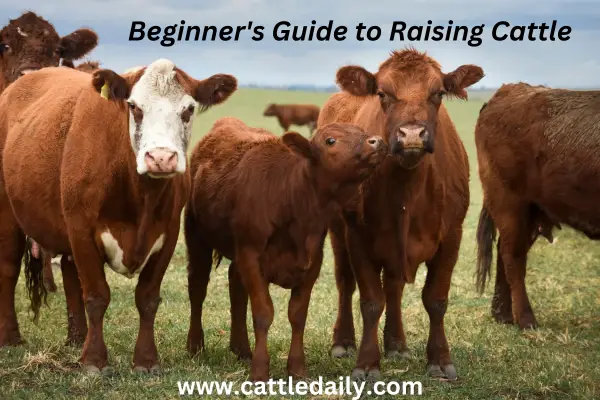Beginner’s Guide to Raising Cattle
Raising cattle can be a fulfilling and profitable endeavor, but it also comes with major responsibilities. From providing adequate facilities and nutrition to managing breeding, calving, and health, beginners have much to learn.
While cattle ranching takes dedication, the rewards of nurturing a herd are well worth the effort. This guide covers key practices and considerations for novice cattle producers. Whether you’re interested in a small herd of beef cattle or becoming a dairy farmer, use these tips to build a successful cattle operation.
In this blog post, we will provide you with a step-by-step guide to raising cattle and making a profit.
Determine Your Purpose
Before purchasing any cattle, think carefully about your goals for having a cattle operation. Key questions to consider:
- Is this for personal consumption or generating income?
- Will you raise breeding stock or cattle to sell for slaughter?
- What breed characteristics match your purpose (meat quality, milk production, etc)?
Having clear goals will help select the best cattle types and guide your management approach.
Choosing the Right Cattle Breed
Choosing the right cattle breed for your farm is one of the most important decisions you’ll make. Take time to research the pros and cons of different breeds. Key factors to consider include:
- Climate – Some breeds like Black Angus do better in colder climates, while Brahmans handle heat. Select a breed adapted to your region.
- Temperament – Docile, calm breeds like Hereford and Jersey work best for beginners. Avoid excitable breeds that can become more aggressive.
- Calving Ease – First-time mothers need breeds like Angus that birth smaller calves easier. Larger calves of Holsteins often require assistance.
- Milking Ability – Dairy producers prefer Holstein for its very high milk output. Beef cattle need just enough milk for calves.
- Market Demand – Commercial ranchers should select breeds in demand by beef processors and consumers.
- Cost – Popular breeds are more expensive. Lesser-known breeds can offer affordability.
Talk to reputable breeders to learn the pros and cons of specific breed bloodlines before purchasing cattle.

Purchase Quality Cattle
Work with reputable cattle breeders to locate and purchase animals suited for your needs. Here are tips for selecting quality cattle:
- Buy locally adapted breeds from healthy, disease-free herds
- Choose cattle with good body condition and structural soundness
- Opt for gentle dispositions for ease of handling
- Look for cows with good udder development if breeding
- Ask about the birth weights of bulls to avoid calving issues
- Quarantine new cattle before introducing them to your herd
Take time to inspect cattle closely before purchasing. This helps avoid introducing health issues into your herd.
Providing Adequate Housing and Facilities
Proper housing and facilities are essential to raise cattle efficiently and comfortably. Basic needs include:
- Barns or Shelters – Provide refuge from cold winds, rain, and snow. Allow 50-100 square feet per animal. Keep dry and well-ventilated.
- Handling Equipment – Invest in head gates, squeeze chutes, cattle crates, and sorting pens for safe handling during vet checks, breeding, calving, etc.
- Fencing – Pasture and paddock fencing should be strong and high enough. Barbed wire or electric wires work best.
- Water Systems – Reliable, clean water is vital. Provide access to automatic waterers, troughs, or tanks. Allow 3-4 gallons daily per cow.
- Feeders – Covered feeders keep hay and other feeds clean and dry. Provide 2-3 feet of feeder space per cow.
Take time to properly plan and equip your cattle facilities. This makes a big difference in day-to-day management.
Formulating a Nutritionally Balanced Diet
Feed makes up the highest cost of cattle production. Providing optimal nutrition is key. A balanced cattle diet consists of:
- Roughages – Fresh pasture, hay, and grass silage supply fiber, protein, and energy. Make up 60-80% of the diet.
- Grains/Concentrates – Corn, oats, and barley add calories for growth and lactation. Start calves at 0.5-2 lbs daily.
- Mineral Supplements – Free choice loose salt, and salt licks provide essential minerals like calcium, phosphorus, and magnesium.
- Vitamins – Alfalfa hay has vitamins A, D & E. Supplement if cattle lack quality forage.
- Clean Water – Vital for health. Allow unlimited, free access. Consumption ranges 15-30 gallons daily.
Work closely with a nutritionist to formulate cost-effective rations meeting cattle needs. This prevents under or over-feeding.

Implementing Proactive Health Management
Preventive healthcare is crucial for keeping cattle healthy and productive. Work closely with a large animal veterinarian to set up an effective health management plan.
- Vaccinations – Vaccines prime the immune system against common bovine diseases. Core vaccines may include IBR, BVD, PI3, BRSV, leptospirosis, clostridia, and more. Follow your vet’s advised schedule for initial shots and boosters.
- Parasite Control – Internal parasites can impair growth and feed efficiency. Dewormers eliminate harmful worms. Fecal tests help inform proper deworming products and timing.
- Biosecurity – Limit disease introduction by requiring proof of vaccination for incoming cattle. Isolate new arrivals until cleared. Control access to your farm. Sanitize equipment and boots between pens.
- Vet Checks – Schedule routine vet exams to catch issues early. Your vet can also provide advice on nutrition, breeding, calving and more.
- Records – Document all health events, treatments, vaccinations, and exam notes. This aids disease monitoring and appropriate care.
- Facilities – Have dedicated sick pens for isolation. Follow strict sanitation protocols. Proper ventilation, drainage and space also support health.
With proactive health management, you can avoid many costly illnesses and achieve optimal growth and productivity.
Breeding Cattle for Healthy, Viable Calves
Breeding and calving processes require diligent oversight. Key tips include:
- Breeding Age – Wait until heifers reach 65-75% of mature weight before first breeding – usually around 15 months. This allows proper reproductive tract growth.
- Breeding Window – Limit mature cow calving interval to 12 months. Rebreed cows 60-90 days after calving for best conception rates.
- Bull Selection – Select bulls with calving ease genetics to reduce birth complications. Avoid extremely large calves.
- Maternity Area – Provide individual, deeply bedded calving pens for bonding and calf comfort. Shelter cows from weather extremes.
- Calving Assistance – Watch for signs of labor trouble. Intervene only if needed based on position/presentation. Call the vet for advice.
- Recordkeeping – Note breeding dates, calf births, IDs, and health observations. This supports proper management.
- Colostrum – Ensure newborn calves ingest quality colostrum immediately after birth to acquire passive immunity.
Following these best practices will lead to increased calf crops and vigorous calf health.
Handling Cattle Safely and with Low Stress
Cattle have powerful survival instincts that kick in if they feel threatened. Use gentle, low-stress handling to avoid dangerous behaviors.
- Work at calm pace in cattle’s flight zone without sudden movements
- Use sorting pens, chutes and anti-backup gates designed for cattle’s natural tendencies
- Eliminate yelling or loud noises which raise stress levels
- Schedule handling for cooler times of day when cattle are calmer
- Provide a lead-trained pilot animal to gently direct the herd
- Reward docile behavior with quiet praise; never beat or prod
- Ensure facilities have no sharp corners or protrusions
- Never turn your back to aggressive animals; always have an escape route
Following these practices reduces fear, prevents injuries, and improves both cattle welfare and productivity. With time, patience and positive reinforcement, cattle become compliant partners during handling.
Market Your Cattle Effectively
Markets exist for selling cattle for breeding, raising dairy heifers, and selling feeder cattle to feedlots. Here are some marketing tips:
- For breeding, advertise in cattle publications and online forums
- Contact artificial insemination companies who may buy top genetics
- Sell quality heifers to other dairies looking for herd replacements
- Partner with reputable livestock brokers to market feeder cattle
- Consider selling beef directly to consumers through local ads
- Explore niche beef markets like grass-fed or organic beef
Choose marketing approaches aligning with your principles and profitability goals.
Tips for Beginner Cattle Farmers
Start Small
Begin with a manageable number of cattle that you can care for appropriately. Slow growth allows learning the ropes while minimizing risks.
Network with Other Cattle Farmers
Join local cattle breeder associations. Attend conferences and seminars. Learn from those with experience.
Take Advantage of Educational Resources
Enroll in courses on livestock management. Read books from experts. Access online resources like Penn State’s beef cattle portal. Continuing education helps refine best practices.
Conclusion
While launching a new cattle operation brings challenges, beginners willing to continuously learn and invest in their herd can thrive. Use this guide as a starting point for core cattle care and management. As you gain experience, continue expanding your knowledge.
Connect with local ranchers, agriculture extension resources, and veterinarians to refine your practices. With diligence and passion, raising cattle can become one of the most rewarding endeavors. Enjoy the special experience of tending cattle while supplying food and resources for your community. Learn here more about animal farming tips and guides.
FAQs:
Q: What is the easiest breed of cattle for beginners?
A: Beginner-friendly cattle breeds include Angus, Hereford, Jersey, Holstein, and Dexter. They tend to be smaller, more docile, and easier to handle.
Q: How much land do you need to raise cattle?
A: You need at least 1-2 acres of pasture per cow. The amount of land needed depends on factors like herd size, forage quality, and whether you manage rotational grazing.
Q: What do cattle eat?
A: Cattle are ruminants that eat a plant-based diet of grasses, hay, silage, corn, soybean meal, vitamins, and minerals. They should be fed a balanced ration to meet protein and energy needs.
Q: How much does it cost to raise a beef cow per year?
A: Annual costs to raise a beef cow range from $800-$1200 which includes feed, veterinary care, facilities, labor, equipment and other expenses. Total startup costs average $2000-$5000 per beef cow.
Q: How do you take care of a newborn calf?
A: Ensure calves quickly ingest colostrum, disinfect navels, provide clean bedding, monitor for nursing and illness signs, handle gently to imprint on humans, tag for identification.
Q: What vaccinations do cattle need?
A: Common vaccines for cattle include 7-way clostridial, IBR, BVD, PI3, BRSV, pinkeye, and leptospirosis. Your vet can advise vaccination schedule.
Q: What is the most profitable cattle to raise?
A: Angus, Hereford and crossbred calves tend to have among the highest returns per cow. But profitability depends on many factors, including breed choice, markets, and cost efficiency.
Q: How do you tell when a cow is ready to calve?
A: Signs a cow is near calving include udder engorgement, relaxation of pelvic ligaments, mucus discharge, and behavioral changes like isolation seeking.

